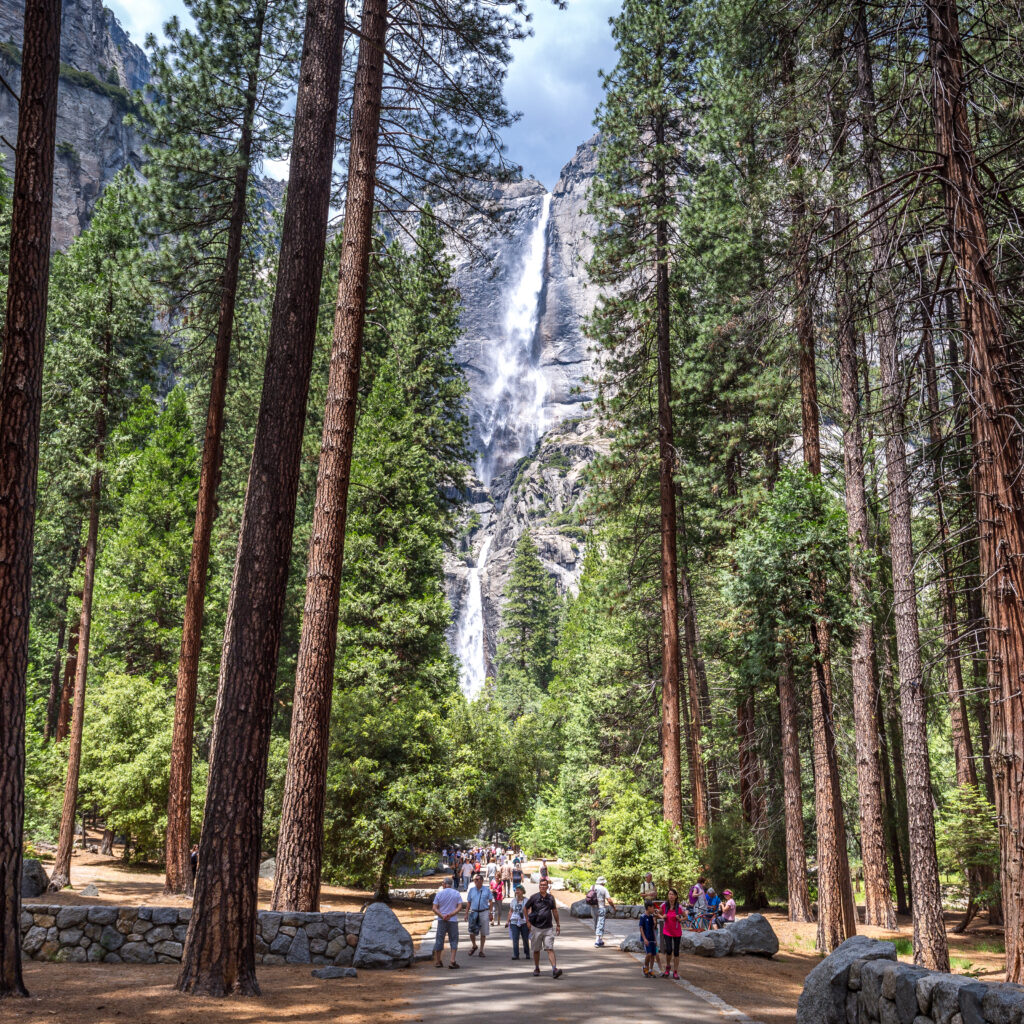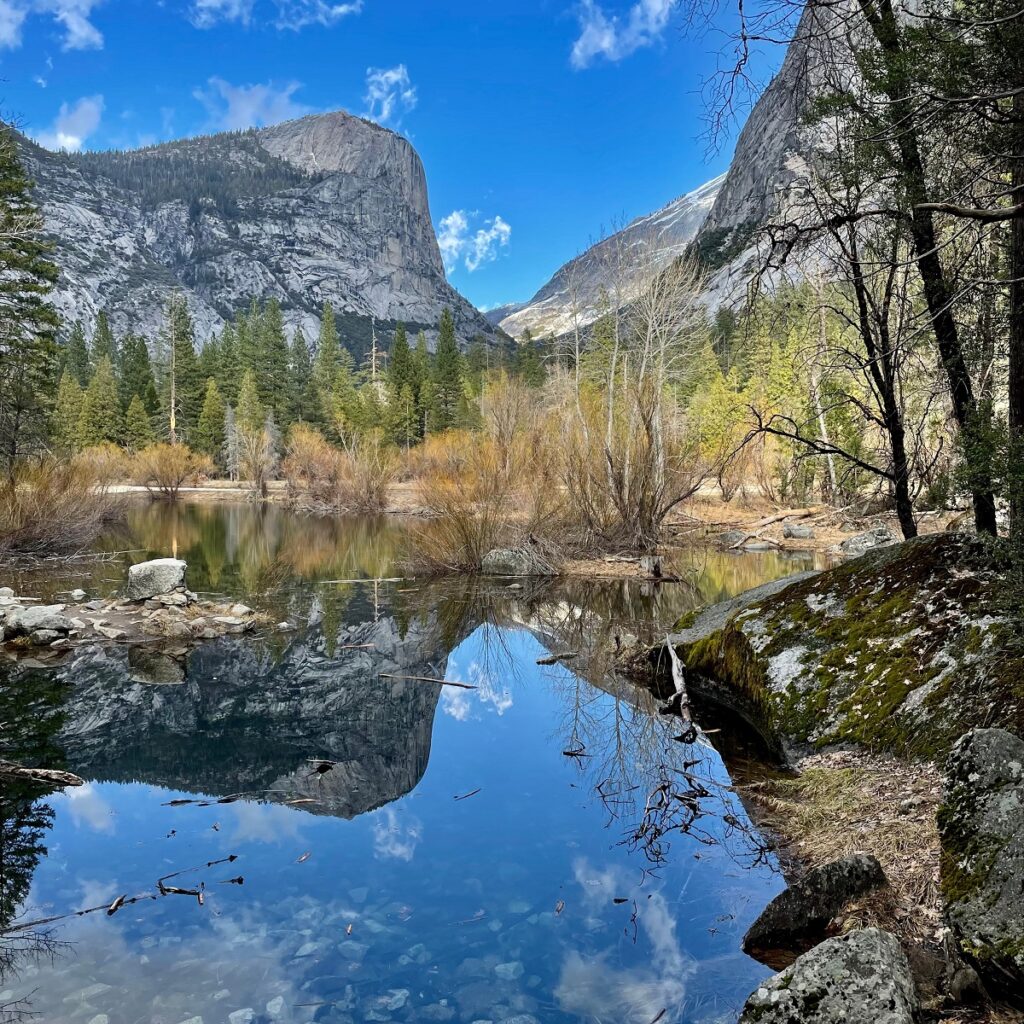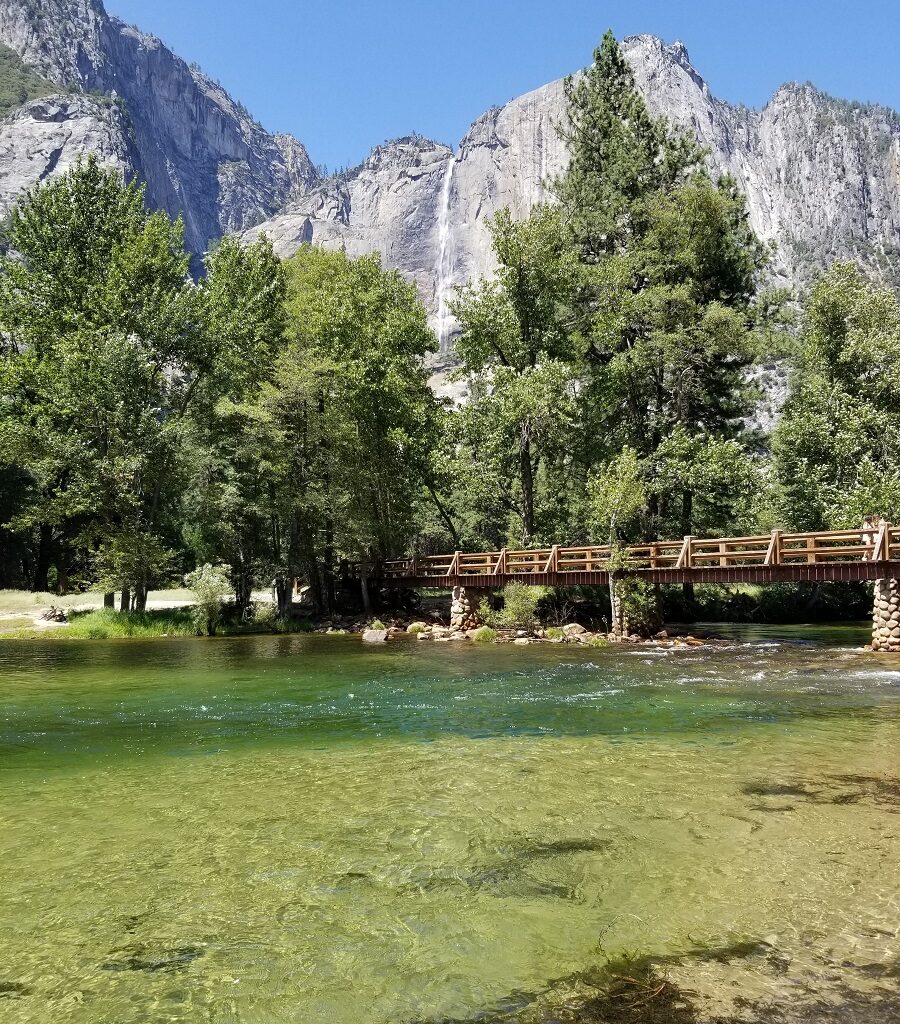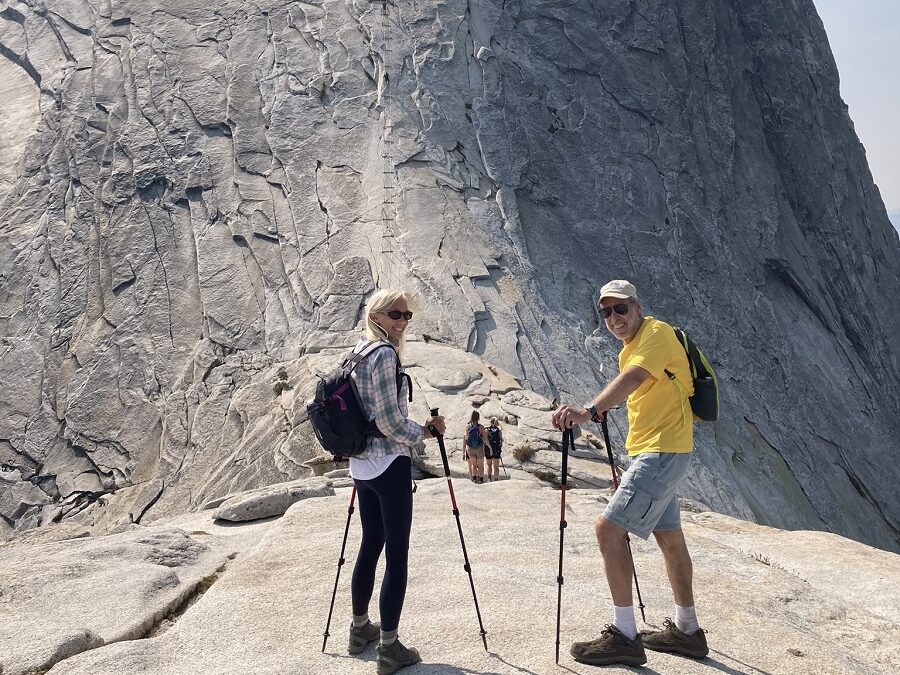For over a century, Yosemite National Park has awed and amazed visitors with its natural beauty. Much of that beauty is seen as you explore the hiking trails within the park, and with over 800 miles of trails, we are sure that you will find the right one for your skill and adventure levels.
Some hiking trails lead to the top of waterfalls towering as tall as 200-story buildings. Others take you to the top of granite domes stretching over 8,800 feet above sea level. Then others simply lead you around expansive meadows filled with wildflowers.
From late spring until early fall, all of Yosemite’s trails are accessible including those found on Tioga Road and Glacier Point Road. If you are hoping to see full-flowing waterfalls, late spring to early summer is the best time to visit Yosemite. If you’d rather avoid the summer crowds but still enjoy your hike, visit during the fall. The temperatures are cooler, and the crowds greatly diminish. Summer is great for all activities at Yosemite including hiking and camping.
With over 100 trails found within the park, deciding which ones to hike can intimidate, especially first-time visitors. You might ask yourself, “How do I choose the best day hikes in Yosemite? How many days do I spend in Yosemite? Will I miss the best views because I chose the wrong trail?”
Yosemite Hotels is here to help. Since there are so many trails to explore throughout the park, we have limited this list to the best day hikes in Yosemite Valley. We have also broken our list down by trail difficulty. Remember, before setting off on any Yosemite day hike, be sure you have your bag packed with all the essentials. Stop by our General Stores at Rush Creek Lodge and Evergreen Lodge if you find you are missing any items.
Best Day Hikes in Yosemite Valley
Yosemite Valley is the park’s central hub and is accessible no matter what time of year you are visiting. This is the primary location for parking if you are planning to hike any of the trails on our list. Here you can find a map of the trailheads for these Yosemite Valley hiking trails. (They are all accessible from the Valley.) Look for the parking lot closest to the trail you plan to hike or take the Yosemite Valley shuttle system which serves all stops in Yosemite Valley, including trailheads, free of charge.
Easy Day Hikes In Yosemite Valley
For beginners, families with kids or those looking for a more relaxed hiking experience, here are the easiest (and most popular) day hikes in Yosemite Valley:

Lower Yosemite Falls Trail
- Distance of Trail: 1 mile round trip
- Elevation Gain of Trail: 50 feet / 15 meters
- Crowd Level of Trail: high
- Time to hike the Trail: 30 minutes – 1 hour
Yosemite Falls stands over 2,400 feet tall, the highest waterfall in North America and the 5th tallest in the world. The trail to the Lower Yosemite Falls is one of the most iconic in the park, and with a fully paved path, it is accessible for all. May through July is the best time of year to complete this day hike to see the waterfall flowing to its fullest.
Sentinel / Cook’s Meadow Loop
- Distance of Trail: 2.25 miles round trip
- Elevation Gain of Trail: none
- Crowd Level of Trail: high
- Time to hike the Trail: 1 – 2 hours
This trail is also extremely popular, but it will give you a chance to soak up more of the beautiful landmarks and views you may have missed on your drive into the Valley. Within the Valley, there are numerous entry points to this trail. You can hop on or off the trail at any of the landmarks along the way including Sentinel Bridge, Yosemite Chapel, The Swinging Bridge, the trailhead of the Lower Yosemite Falls and Cook’s Meadow. This trail is part of the much longer Valley Trail Loop, which circles completely around the Valley.

Mirror Lake Loop
- Distance of Trail: 2.4 – 4 miles round trip
- Elevation Gain of Trail: 100 feet / 30 meters
- Crowd Level of Trail: high
- Time to hike the Trail: 1 – 3 hours
Mirror Lake is a hot spot for swimming during the summer months in Yosemite, but beyond swimming, this trail boasts beautiful views of the face of Half Dome. It also is the prime location for some amazing photography. Just wait until you see the reflections of the Valley in the lake! By simply hiking the trail from the trailhead to Mirror Lake and back, the route is about 2.4 miles. To complete the loop past Mirror Lake and around Tenaya Canyon, the trail is 4 miles round trip.
Moderate Day Hikes In Yosemite Valley
Once you have warmed up your hiking legs and are ready for the next adventure, it’s time to try one of the moderate day hikes found in Yosemite Valley. Not only does the length of these trails increase in difficulty, but the elevation changes are much larger than our list of easy day hikes. Here are our favorite moderate day hikes in Yosemite Valley:

Mist Trail
- Distance of Trail: 3 – 7 miles round trip
- Elevation Gain of Trail: 1,000 – 1,900 feet / 300 – 580 meters
- Crowd Level of Trail: medium – high
- Time to hike the Trail: 2 – 5 hours
The Mist Trail is known for its many views and multiple vantage points of Half Dome, Liberty Cap and two waterfalls. This trail is also popular for the intense flow of the waterfalls, particularly Vernal Falls which will leave you soaked through if you visit during spring.
Again, you have the option to enjoy a shorter or longer hike on the Mist Trail. Starting at the trailhead to Vernal Falls and back is around 3 miles. If you are feeling adventurous, continue to Nevada Fall to complete the full 7-mile trail. If you decide to continue to Nevada Fall, the hike becomes more strenuous, but the views will be worth the workout. There is also the option to take your return trip down the John Muir Trail. This will add an extra mile or so to your adventure, but it will also add even more breathtaking scenery!
Upper Yosemite Falls Trail
- Distance of Trail: 7.6 – 9.4 miles round trip
- Elevation Gain of Trail: 2,600 – 2,969 feet / 790 – 890 meters
- Crowd Level of Trail: low – high
- Time to hike the Trail: 6 – 10 hours

Yosemite Falls
Many have called the hike to the Upper Yosemite Falls the ultimate stair-master workout. After the first mile, you will have climbed 1,000 feet in elevation via dozens of switchbacks and reached Columbia Rock. Take a breath and snap a few photos. Once you continue along the trail, you will climb another set of steep switchbacks before reaching the top of the falls. From the top of Yosemite Falls, you will gaze upon the Valley below and surrounding granite cliffs.
Once you have made it this far, you have the option to climb a little further to reach Yosemite Point. This stretch will add less than 2 miles total to your hike but will give you a chance to snag some incredible photographs. This point boasts the best views of Half Dome and some of the most beautiful in the park.
Strenuous Day Hikes In Yosemite Valley
For the extreme sports enthusiasts, Yosemite Valley offers a few of the best strenuous hikes in the park for you to enjoy. Most of these trails will take almost the entire day to complete. Pack your bags and get ready for a strenuous day hike in Yosemite Valley.
Snow Creek Trail
- Distance of Trail: 7.2 miles round trip
- Elevation Gain of Trail: 2,700 feet / 820 meters
- Crowd Level of Trail: low – medium
- Time to hike the Trail: 6 – 7 hours
What makes Snow Creek Trail stand out among the rest is its intensely steep and short trek from the Valley floor to the rim. The intense switchbacks on Snow Creek Trail take you from bottom to top in 1.7 miles. For comparison, the Upper Yosemite Falls Trails stretches 3.2 miles to make this climb, and the Four Mile Trail takes 4.7 miles to cover the same elevation increase.
The trail starts easy and crowded as you make your way down Mirror Lake Loop. Past Mirror Lake at the far end of Tenaya Canyon, you will find the Snow Creek Trail junction. From here, it’s straight up to the top with fewer crowds and a much more intense hike.
This trail is also accessible via Tioga Road. Taking this route you will add about 3 miles to your total hike, but the hike is far more moderate. On this route, you will descend to Snow Creek versus climbing up, and the elevation change is stretched across 5 miles versus Snow Creek Trail’s 1.7-miles.

Four Mile Trail
- Distance of Trail: 9.4 miles round trip
- Elevation Gain of Trail: 3,200 feet / 975 meters
- Crowd Level of Trail: medium
- Time to hike the Trail: 5 – 10 hours
From the Swinging Bridge in the Valley to the top of Glacier Point, Four Mile Trail gives hikers some of the best views of Yosemite Falls from top to bottom. Also, this is one of the few trails in the park that has vehicle access at both ends. If you have the vehicles to arrange a “personal” shuttle, you could hike this trail one way cutting your distance and time in half.
If you choose to make the full hike up and back, you have the option to take an alternate route back down to the Valley via the Panorama Trail. Combining these two trails gives you added views of the Illilouette, Nevada and Vernal Falls, added elevation of around 800 feet and almost 5 additional miles. Consider that the trailheads for these hikes are about 3 miles apart. Once again, the views you will gain can make all those added miles worth it.

Half Dome Trail
- Distance of Trail: 14.2 – 23 miles round trip
- Elevation Gain of Trail: 4,800 feet / 1,600 meters
- Crowd Level of Trail: high (limited)
- Time to hike the Trail: 10 – 14 hours
We saved the best for last. This all-day hike provides some of the best views within the park, but it also is one of the most dangerous trails. The trail is only open from around Memorial Day in May to Columbus Day in October; they remove the climbing cables during all other times of the year.
There are two important things to know about Half Dome. First, a permit is required to climb the last 400 feet up the backside of Half Dome using the cable route. (Anyone may make the hike as far as the subdome.) Permits for Half Dome day hikers are distributed via a lottery system. Applications open at the end of March for the following season. If you are not chosen during this initial lottery, you do a chance to receive a day hike permit by submitting an application two days before you plan to hike.

Cable Route at Half Dome
There are 225 day-hike permits distributed for each day of the week, and the remaining 75 permits are reserved for backpackers who plan on spending the night at the Little Yosemite Valley campground before their Half Dome hike. (Those who receive backpacker permits for Half Dome are still required to apply for a wilderness permit for an overnight adventure within the Park.)
Second, be sure to plan ahead and prepare for what you might need while on your Yosemite day hike, especially for the Half Dome Trail. For example, waterproof hiking boots are needed no matter which trail you choose to hike. For the Half Dome Trail, you will also need to bring nitrile-coated gloves for climbing the cables. It is best to pack for all possible situations rather than finding yourself missing an important item in an emergency.
You have the option of several trails to access Half Dome, a few that we have already discussed. First, you could take the Mist Trail past the Vernal and Nevada Falls, jump onto the John Muir Trail at the junction and continue to the Half Dome Trail. This route is the shortest trail at 14.2 miles.
You could also take the John Muir Trail the entire way from Vernal Falls Bridge, past Clark Point to the Half Dome Trail. This route is around 16.5 miles. There is also a route via the Panorama Trail from Glacier Point that stretches around 20 miles, or the route from Tenaya Lake is the longest totaling around 23 miles. No matter which route you choose, if you are one of the honored individuals to receive a Half Dome hiking permit, you are in for a true adventure.

